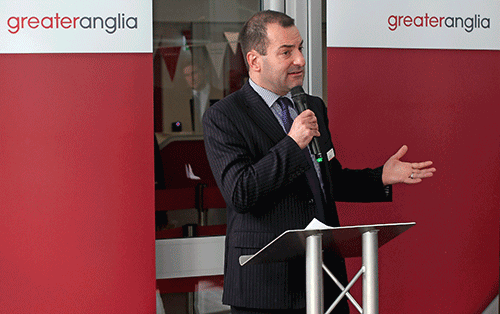 Greater Anglia and Network Rail’s offices sit high above the Westfield shopping centre at Stratford. From there, managers can see a massive change in the landscape - where once there was only railway land, today there are flats and shops built as part of the regeneration brought not only by the 2012 London Olympics, but also by the railway.
Greater Anglia and Network Rail’s offices sit high above the Westfield shopping centre at Stratford. From there, managers can see a massive change in the landscape - where once there was only railway land, today there are flats and shops built as part of the regeneration brought not only by the 2012 London Olympics, but also by the railway.
For GA Managing Director Jamie Burles, that landscape will be further transformed in the next few years of his control.
August 10 was a landmark day for the region, maybe even for the rail industry. The Government awarded Abellio a nine-year concession to operate the Greater Anglia franchise that it had been running since February 2012 (albeit via two Direct Awards).
The undoubted headline was the entire fleet replacement. This is the largest ever fleet replacement on one franchise - everything will be replaced, and the number of vehicles will be increased.
Currently GA operates 937 vehicles (to increase to 1,009 next summer via a small cascade of trains), dating from 1975 to 2011. From 2019, that number will increase to 1,037. But by the time the next GA franchise begins, the oldest train will be just six years old - at the start of this franchise, the oldest vehicle was 41 years old (not including the 50-year old Class 37s hired from Direct Rail Services).
Burles joined what was Abellio Greater Anglia in mid-2014. Previously Bid Director for Abellio Group, he replaced Ruud Haket, who had led the first Direct Award (DA).
Burles was bullish from the start about what the region wanted… and needed. He was delighted that the DA at the time included merely a refresh for the ageing Mk 3s rather than a full refurbishment, as that (he said at the time) suggested new trains could be on the way.
The new franchise had been due to be announced in June, with the start in October. But then the Brexit referendum was set for June 23, and that changed the timetable (although this was a question Government regularly deflected when asked).
Local campaigners wanted (nay, demanded) big improvements, and the Great Eastern Main Line Taskforce became ever more influential after it was set up by then-Chancellor of the Exchequer George Osborne. Influential businesses and stakeholders, led by New Anglia Local Enterprise Chairman Mark Pendlington, were vocal in their calls for improvements, and in 2014 they produced a study stating that £476 million of infrastructure improvements (combined with new trains) could transform the region. For every £1 spent £9 could be raised, the report stated.
Everything was set for the June announcement. There had been calls for new trains, and for WiFi-enabled brand new stock to serve coastal branches and branch lines around the region. But that announcement was delayed until August, owing to Brexit and the subsequent Cabinet changes. That left the winner with a little over two months to mobilise the new franchise.
Looking back, Burles smiles at that period. “The delay? Yes, there was great uncertainty with even letting the franchise. We know there was extreme turbulence in the corridors of power. It wound its way to a conclusion, but it meant mobilisation was two months instead of three. It meant we were extraordinarily busy in getting it sorted.”
He says that “apart from stress and grey hairs, we managed to cope”. And the new franchise started, as planned, on October 16.
Burles is also keen to point out that it was Anglia’s turn for new trains. All around the country new trains were on order or were planned, and yet AGA, despite delivering a large subsidy to Government and serving an area that was one of only two to contribute positively to the UK’s GDP, was making do with cast-offs. Since 2003, 21 four-car Class 360s and 30 four-car Class 379s were the sum total of two franchises and two Direct Awards.
So how did the region manage to convince the DfT to buy into Anglia’s vision?
“There were a number of things coming together,” explains Burles, who particularly acknowledges the concerns of various areas within the overall region. Authorities that previously had only ‘batted for themselves’ joined forces for the ultimate aim - to improve the entire region rather than an individual county.
“There used to be disagreements for individual regions. The start of the process was corralling the key stakeholders for objectives.”
The big news, of course, are the new fleets. What were Burles’ priorities for the franchise?















Login to comment
Comments
No comments have been made yet.